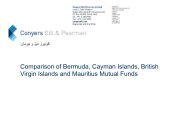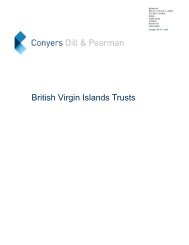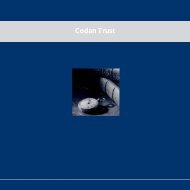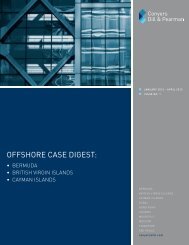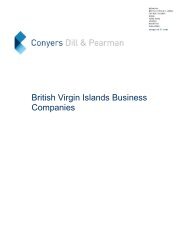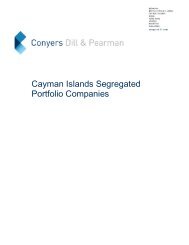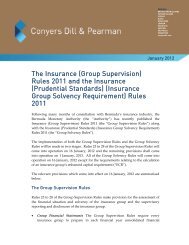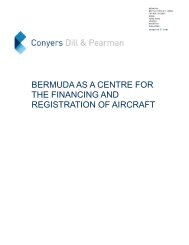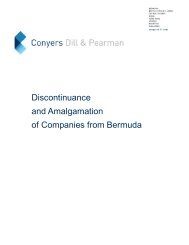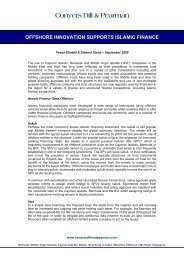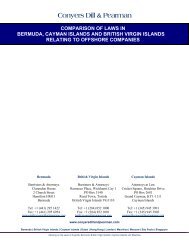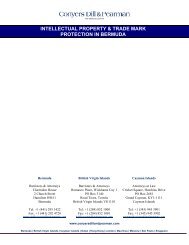OFFSHORE CASE DIGEST: - Conyers Dill & Pearman
OFFSHORE CASE DIGEST: - Conyers Dill & Pearman
OFFSHORE CASE DIGEST: - Conyers Dill & Pearman
You also want an ePaper? Increase the reach of your titles
YUMPU automatically turns print PDFs into web optimized ePapers that Google loves.
CAYMAN ISLANDSJanuaryCOMPANIES – WINDING UP – TRANSACTIONAPPROVAL PROCEEDING COSTSIn the Matter of the Companies Law (2011 Revision) andIn the Matter of Emergent Capital Limited (In Liquidation)between KTC and RAAL Limited, Grand Court of theCayman Islands Financial Services Division, Cause No.FSD 29 or 2011, per Jones, J. (5 January 2012)The company’s official liquidators brought a sanction applicationseeking directions in respect of a dispute about the respectiveshareholdings of the company’s only two shareholders.Pursuant to the directions of the Court in that application, thematter was conducted as though it were an action inter partesbetween those two shareholders. The official liquidators hadno ongoing involvement in the application: One shareholderdefended against the other’s claim in its own interest. At theconclusion of the matter, the Court held that costs should followthe costs in the cause. Leave to appeal of the order for costswas sought and denied. The decision turned on the propercharacterization of the application. If properly characterizedas a sanction application, principles contained in CompaniesWinding Up Rules (“CWR”) Order 24 would apply, in whichcase costs would ordinarily be payable out of the assets of thecompany. If properly characterized as an inter partes applicationbetween the shareholders, the principles contained in GCR O.62, r. 4 would apply, under which costs would generally followthe event. The Court found that as a matter of procedure theapplication was a sanction application. However, in substance,this application was conducted as an action between the onlyparties in interest. CWR Order 24, r.9(5) permits the Court tohave regard to the substance of the matter and not merelyits procedural form. Given the substance of the matter, it wasappropriate to order costs as though this were an action interpartes. Despite the fact that KTC lost (or withdrew its pleading)on all but one of the issues, it was nevertheless correctlyidentified as the successful party overall. The issues on whichKTC lost did not add to the costs of the application in a verymaterial way. As such, it was appropriate to treat KTC as thesuccessful party and it should have the whole of its costs ofthe application.COMPANIES – SCHEME OF ARRANGEMENT – MAJORITYIN NUMBER – COUNTING CUSTODIAN VOTESIn the Matter of Sections 15 and 86 of the Companies Law(2010 Revision) (as amended) and In the Matter of theGrand Court Rules 1995 Order 102 and In the Matter ofLittle Sheep Group Limited, Grand Court of the CaymanIslands Financial Services Division, Cause No. FSD 182 of2011, per Jones, J. (20 January 2012)The company, listed on the main board of the Hong KongStock Exchange, sought to privatize by way of a schemeof arrangement under Section 86 of the Companies Law.Under that section, a scheme becomes binding only if (a) itis approved by a majority in number representing seventyfivepercent in value of the Company’s members and (b) itis sanctioned by the Court. An application for directions wasbrought to the Court on the question of how to calculate thestatutory majority requirement in the context of a companywhose shares are held primarily through a single custodian orclearing house. It was acknowledged that the phrase “majorityin number” implies a simple head-count. However, the Courtnoted that in this context it was perfectly entitled to take noticeof the fact that custodians and clearing houses are not thebeneficial owners of the shares registered in their names. Suchan entity can only vote the shares registered in its name inaccordance with the instructions received from its members orclients. When shares are registered in the name of a custodianor clearing house, the Court is bound to treat it as a member ofthe company but it is also entitled to treat it as a multi-headedmember for the purpose of the count. As such, the clearinghouse was permitted to vote both for and against the schemein accordance with the instructions from its participants. Thehead count would be calculated by figuring the number of votescast in favour of the scheme and the number of participantson whose instructions they are cast and the number of votesconyersdill.com • 18



